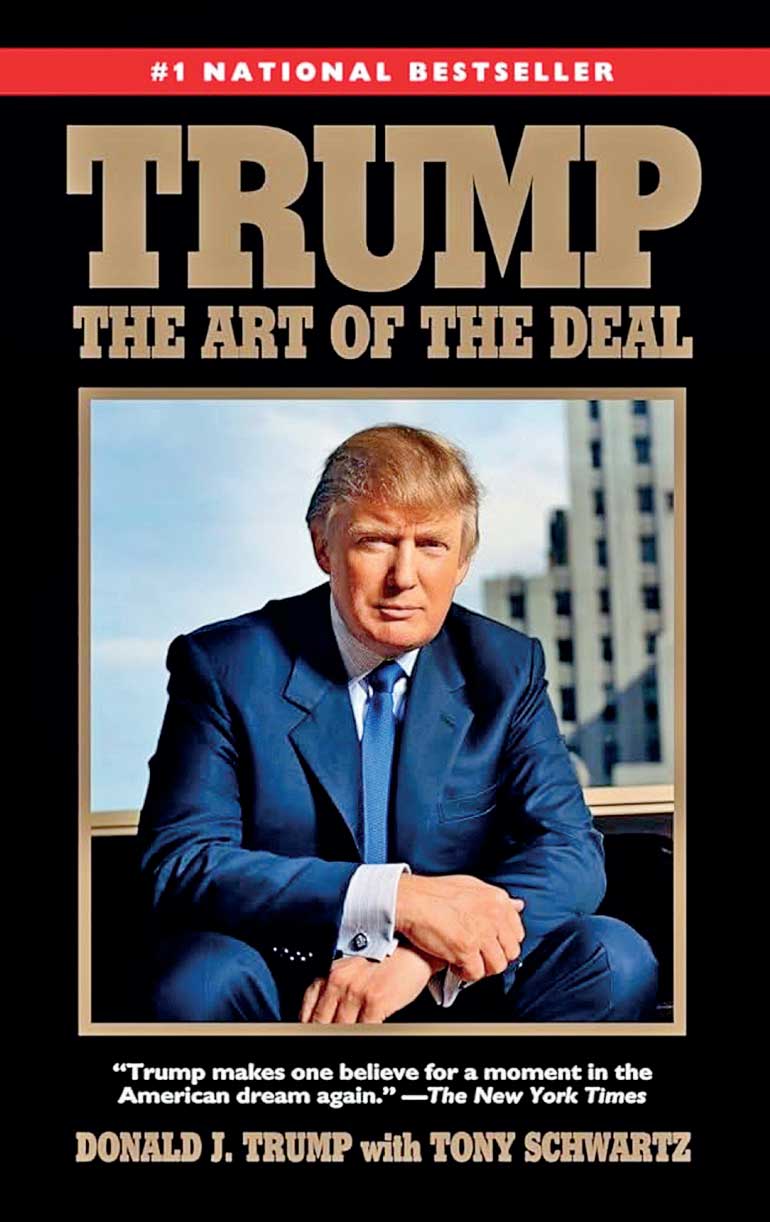Sunday Apr 13, 2025
Sunday Apr 13, 2025
Thursday, 10 April 2025 00:22 - - {{hitsCtrl.values.hits}}

The Art of the Deal was released in 1987. The book is credited to
Donald J. Trump and journalist Tony Schwartz
 Donald Trump’s book The Art of the Deal, published in November 1987—which I have read several times—has the core message that success in business and life comes from bold negotiation, relentless self-promotion, and a willingness to break the rules when necessary. To understand and effectively respond to Donald Trump’s tariff-driven trade strategy, one must go back to his founding philosophy outlined in The Art of the Deal.
Donald Trump’s book The Art of the Deal, published in November 1987—which I have read several times—has the core message that success in business and life comes from bold negotiation, relentless self-promotion, and a willingness to break the rules when necessary. To understand and effectively respond to Donald Trump’s tariff-driven trade strategy, one must go back to his founding philosophy outlined in The Art of the Deal.
Trump does not view tariffs merely as economic tools, but as psychological and strategic levers. In his worldview, trade is not a cooperative global enterprise but a zero-sum negotiation where strength, leverage, and unpredictability determine outcomes. Therefore, crafting a response to Trump’s tariff policies requires more than technical economic arguments—it requires a grasp of the deal-making mindset that drives them.
Use of tariffs
Trump’s use of tariffs was central to his America First doctrine. From steel and aluminum tariffs to broader trade actions targeting China, the European Union, and even Canada and Mexico, Trump wielded tariffs as a form of coercion. To him, they were not simply about protecting domestic industries but about rebalancing relationships he believed were tilted against the United States. He made trade personal. This is classic Trump: provoke, disrupt, and then negotiate from a position of perceived strength.
Strategy
Responding to such a strategy begins with decoding the intent. Trump’s tariff moves were rarely ends in themselves. They were opening bids, intended to create leverage and sow uncertainty. Countries and companies that took them at face value often overreacted. Those that paused, analysed, and responded in kind—strategically, not emotionally—often fared better. For example, the EU’s targeted countermeasures and China’s calibrated retaliation showed that a methodical response, rather than panic, was the more effective counter.
Second, it is essential to speak the language of deal-making, not ideology. Trump is rarely swayed by moral or multilateral appeals. He responds to strength, clarity, and a firm ask. When leaders approached him with clear demands and offered a visible “win” he could claim domestically, negotiations progressed. Whether it was Japan adjusting trade concessions or Mexico agreeing to increased border enforcement, Trump responded positively to those who gave him a headline without appearing to concede too much in substance.
Third, economic resilience matters. Trump often gambled on the notion that other countries needed access to the US market more than the US needed them. Therefore, diversifying trade partners, strengthening domestic markets, and building regional alliances were—and remain—critical tools for countries looking to withstand such pressure. The lesson? Make yourself a tougher opponent by reducing dependency and increasing your own leverage.
Finally, one must play the long game. Trump’s trade manoeuvres were often designed for short-term domestic political gain: energising his base, asserting control, or distracting from other issues. A longer-term perspective—grounded in institutional stability and strategic patience—is more sustainable. Countries and businesses that avoided rash countermeasures and focused on future competitiveness emerged stronger.
Conclusion
In short, responding to Trump’s tariffs effectively requires stepping into his world—but not staying there. Understand the spectacle, decode the strategy, and respond with strength, patience, and precision. The Art of the Deal may have been written decades ago, but its core principles continue to shape the tools and tactics of modern economic diplomacy—for Trump himself and his administration. World leaders must grasp this reality to recalibrate their relationship with the United States—at least for the next three+ years.
Reference:
https://www.bbc.com/news/world-us-canada-46822452.amp
Discover Kapruka, the leading online shopping platform in Sri Lanka, where you can conveniently send Gifts and Flowers to your loved ones for any event including Valentine ’s Day. Explore a wide range of popular Shopping Categories on Kapruka, including Toys, Groceries, Electronics, Birthday Cakes, Fruits, Chocolates, Flower Bouquets, Clothing, Watches, Lingerie, Gift Sets and Jewellery. Also if you’re interested in selling with Kapruka, Partner Central by Kapruka is the best solution to start with. Moreover, through Kapruka Global Shop, you can also enjoy the convenience of purchasing products from renowned platforms like Amazon and eBay and have them delivered to Sri Lanka.
Discover Kapruka, the leading online shopping platform in Sri Lanka, where you can conveniently send Gifts and Flowers to your loved ones for any event including Valentine ’s Day. Explore a wide range of popular Shopping Categories on Kapruka, including Toys, Groceries, Electronics, Birthday Cakes, Fruits, Chocolates, Flower Bouquets, Clothing, Watches, Lingerie, Gift Sets and Jewellery. Also if you’re interested in selling with Kapruka, Partner Central by Kapruka is the best solution to start with. Moreover, through Kapruka Global Shop, you can also enjoy the convenience of purchasing products from renowned platforms like Amazon and eBay and have them delivered to Sri Lanka.